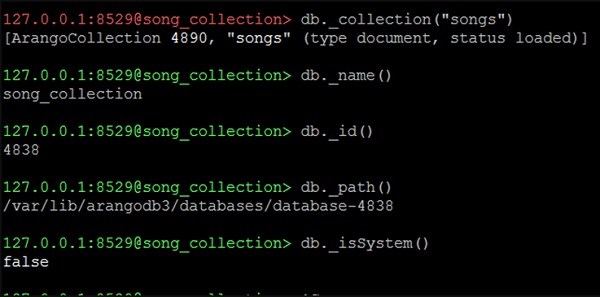
- ArangoDB - Home
- A Multi-Model First Database
- ArangoDB – Advantages
- Basic Concepts & Terminologies
- ArangoDB – System Requirements
- ArangoDB – Command Line
- ArangoDB - Web Interface
- ArangoDB - Example Case Scenarios
- Data Models & Modeling
- ArangoDB - Database Methods
- ArangoDB - Crud Operations
- Crud Operations Using Web Interface
- Querying The Data With AQL
- ArangoDB - AQL Example Queries
- ArangoDB – How To Deploy
ArangoDB - Database Methods
In this chapter, we will discuss the different Database Methods in ArangoDB.
To start with, let us get the properties of the Database −
- Name
- ID
- Path
First, we invoke the Arangosh. Once, Arangosh is invoked, we will list the databases we created so far −
We will use the following line of code to invoke Arangosh −
127.0.0.1:8529@_system> db._databases()
Output
[ "_system", "song_collection" ]
We see two databases, one _system created by default, and the second song_collection that we have created.
Let us now shift to song_collection database with the following line of code −
127.0.0.1:8529@_system> db._useDatabase("song_collection")
Output
true 127.0.0.1:8529@song_collection>
We will explore the properties of our song_collection database.
To find the name
We will use the following line of code to find the name.
127.0.0.1:8529@song_collection> db._name()
Output
song_collection
To find the id −
We will use the following line of code to find the id.
127.0.0.1:8529@song_collection> db._id()
Output
4838
To find the path −
We will use the following line of code to find the path.
127.0.0.1:8529@song_collection> db._path()
Output
/var/lib/arangodb3/databases/database-4838
Let us now check if we are in the system database or not by using the following line of code −
127.0.0.1:8529@song_collection&t; db._isSystem()
Output
false
It means we are not in the system database (as we have created and shifted to the song_collection). The following screenshot will help you understand this.

To get a particular collection, say songs −
We will use the following line of code the get a particular collection.
127.0.0.1:8529@song_collection> db._collection("songs")
Output
[ArangoCollection 4890, "songs" (type document, status loaded)]
The line of code returns a single collection.
Let us move to the essentials of the database operations with our subsequent chapters.